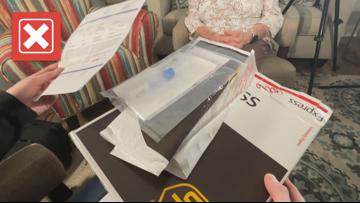Editor's note: VERIFY blurred the child's face in the viral post to protect their identity.
Viral posts are being shared on Facebook about a 2-year-old boy who was reportedly found and brought to a police station. The posts say that “officers have the child safe” but “have no idea where he lives.” An image of a toddler with bruises and scratches on his face is being shared along with the message.
Many of the posts appear in local buy-and-sell groups and instruct members of the groups to share the post so more people can see it. The caption that accompanies the photo ends with “Please Bump this post.”
While the posts include the same image, the boy’s alleged location changes, with some reporting he was found in Milwaukee and others say Sacramento.
THE QUESTION
Are the posts about a missing two-year-old boy at a police station true?
THE SOURCES
RevEye, a reverse image search tool
THE ANSWER
No, the posts about a missing two-year-old boy at a police station are not true. They are part of a bait-and-switch scam.
WHAT WE FOUND
The posts about a missing two-year-old boy at a police station are scams. Scammers are using a real image of a child to play on people’s emotions and get them to share the post. Then they edit the text to a different message that includes malicious links after it has already been shared.
VERIFY searched Facebook and found a number of posts with nearly the exact message and picture being shared in local Facebook groups, however, a different city or town is used each time to say where the boy was found.
VERIFY conducted a reverse image search and found the photos being used in the posts are real. The images are of a 2-year-old boy who was mauled by dogs in Georgia in 2014. The images were sent in by the boy’s mother and shared in an HLN news report on the event. Other news outlets also covered the attack at the time of the incident.


The posts not only make false claims about the boy in the photos, but they’re also later edited in a way that’s consistent with “bait and switch” scams. One post, shared in a Buffalo, New York, car-selling group was changed to share a link to a home rental property. The link was generated with a URL shortener so while it says it's redirecting to a property management team, the real website is unclear and likely a malicious link.
Another post, shared in a Toledo, Ohio garage sale group was also changed to a similar home rental post.
The post, which has over 700 shares, still has comments relating to the missing boy. One comment reads, “I hope this IS fake news but if it's not LETS FIND HIS PEOPLE!!”
Facebook scams that use sensitive subjects like missing children are fairly common. The posts prompt the user to share an important cause with their friends, but after the post is shared the “scammer changes the original post to a deceptive rental ad or sometimes to a link pointing to a survey that ‘guarantees’ a cash prize,” the Better Business Bureau says.
Scammers can then steal personal information through malicious links added to the edited posts.
People may be more susceptible to falling for these scams because they were shared by a friend or seen in buy-and-sell groups with a sense of community.
The Murfreesboro Police Department in Tennessee, posted an alert about one of the posts that linked the boy to Murfreesboro, stating the department hasn’t “received any reports that fit the circumstances contained in it.” It advised users to avoid sharing the post and to take it down if they already had.
To avoid falling for these scams, the BBB recommends looking at the profile of the user who is sharing the post. There are often red flags, such as when an account was created or locations that don’t add up. Conducting reverse image searches or copying and pasting the text to see if the post is being spread with inconsistencies are other ways to spot these scams.
VERIFY reported on a similar scam last year, where scammers posted about an Amber Alert for a 5-year-old girl. That scam used an image generated with artificial intelligence.










